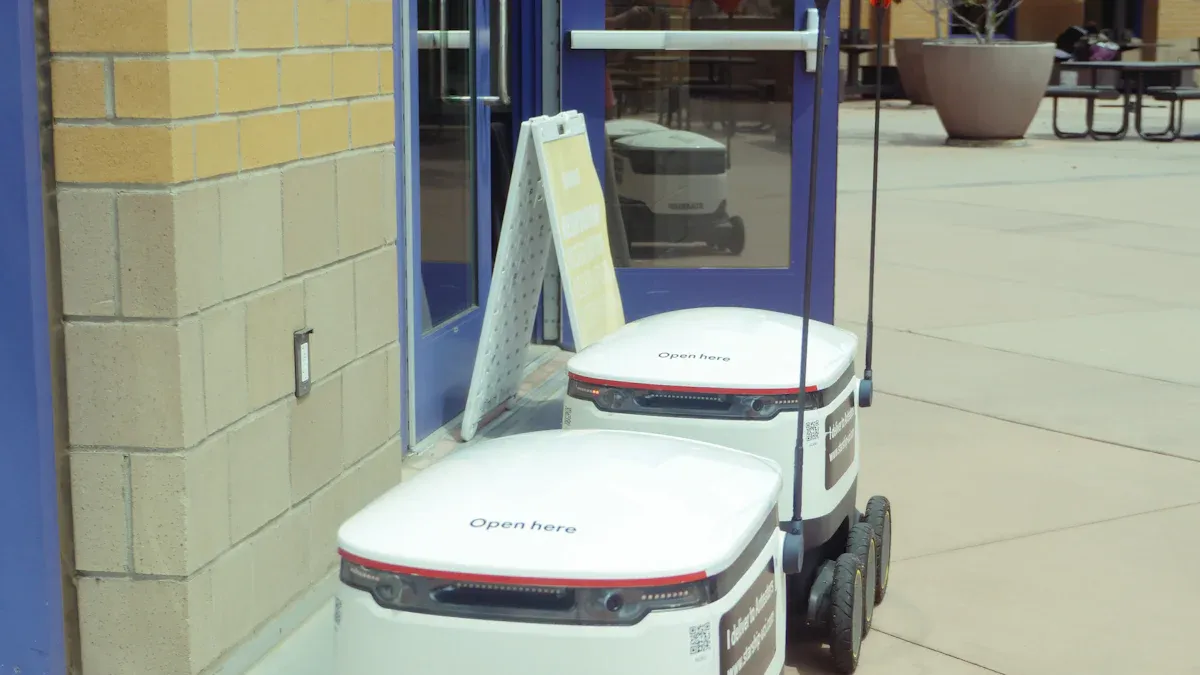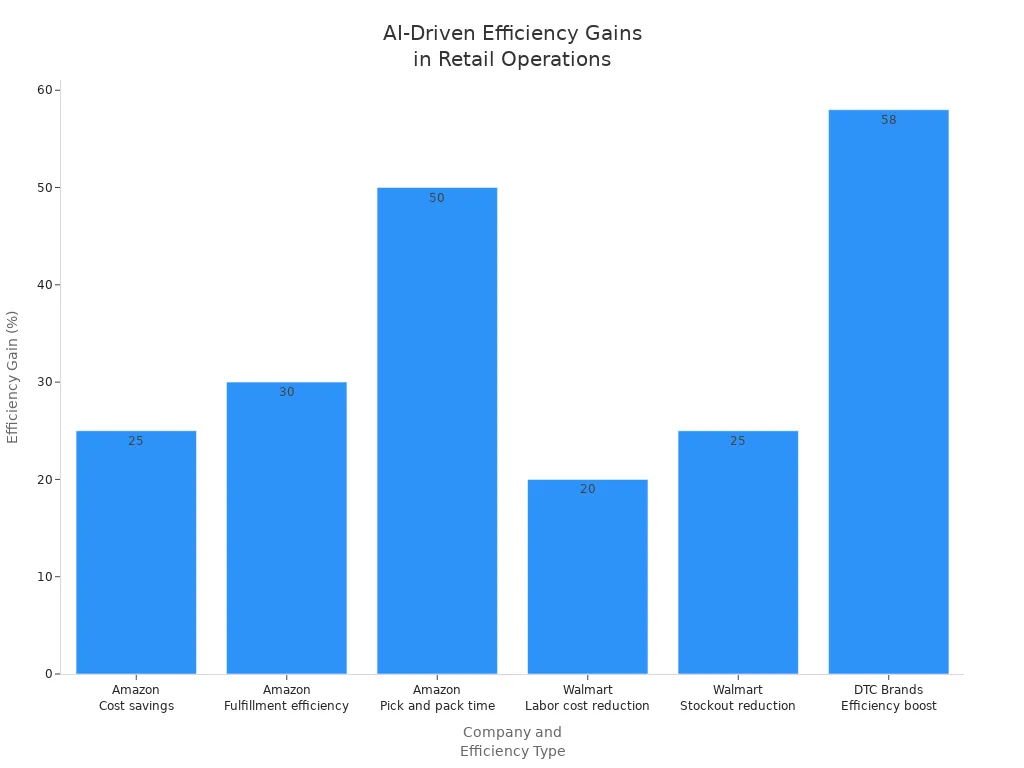How AI Stores Reduce Labor Cost & Increase Efficiency

AI Stores help you cut labor costs and work more efficiently. In 2024, retail productivity grew by 4.6% because stores produced more while using fewer work hours.
Total output went up by 3.3%.
Total hours worked dropped by 1.2%.
Unit labor costs fell by 1.8%.
You benefit from automation, smart predictions, and labor reallocation. These tools make your daily tasks easier and help your team focus on customers.
Benefit Type | Description |
|---|---|
Efficiency | Streamlining repetitive tasks so you can focus on important work. |
Decision-Making | Helping you answer tough questions and manage inventory better. |
Labor Reallocation | Giving you more time to help customers and boost sales. |
Key Takeaways
AI Stores can cut labor costs by automating repetitive tasks, allowing employees to focus on customer service and important work.
Using AI for scheduling helps match staff to busy times, reducing payroll costs and improving employee satisfaction.
Predictive analytics in AI helps retailers forecast demand, ensuring the right products are in stock and avoiding overstaffing.
Automation and smart decision-making tools lead to faster operations, fewer errors, and happier customers.
Investing in AI technology can give your store a competitive edge, improving efficiency and customer loyalty.
AI Stores and Labor Cost Reduction

Automation
You can use automation in AI Stores to cut labor costs and boost productivity. Stores that use autonomous systems often see labor cost reductions of 60-70%. Automation replaces repetitive tasks with machines and software. This means you need fewer people for jobs like stocking shelves, checking inventory, or answering simple customer questions.
Aspect | Description |
|---|---|
Automation substitutes labor | Machines perform tasks with greater precision and speed, reducing the need for human labor. |
Automation complements labor | Remaining human tasks become more valuable as machines handle routine activities. |
Capital and labor augmentation | Frees up human capacity for innovation and new product development. |
AI uses smart algorithms to learn from data and make decisions on its own. This leads to faster and more accurate work. For example, AI chatbots can answer customer questions, while back-office systems handle data entry and order processing. You can also use AI-driven demand forecasting tools to predict what products you need, which helps you avoid overstocking or running out of items.
AI-driven demand forecasting tools analyze past sales data and consumer preferences, enabling retailers to adjust operations dynamically. This reduces the risk of overstocking and understocking, leading to more efficient and cost-effective operations.
When you automate routine tasks, your employees can focus on creative and important work. This shift improves morale and job satisfaction. You also save money by lowering payroll expenses and reducing errors.
Scheduling
AI-powered scheduling tools help you match the right number of staff to the busiest times. These systems can reduce labor costs by 5% to 15% on average. In retail and hospitality, the savings often reach 8% to 15%. If you switch from manual scheduling, you may see even bigger improvements.
Automated Scheduling: AI checks employee availability and skills to build the best schedules.
Demand Forecasting: AI predicts busy times, so you always have enough staff.
Reduced Administrative Burden: Managers spend less time on schedules and more time on strategy.
Enhanced Employee Engagement: Staff can give input on their shifts, which makes them happier.
Real-Time Adjustments: AI quickly changes schedules if someone calls in sick or demand changes.
A major grocery chain used AI scheduling to cut wait times by 30%. This led to happier customers and more repeat visits. When you avoid overstaffing, you can save $250,000 to $500,000 each year. AI scheduling also makes shifts fairer, which lowers turnover by 10-15%.
Staff Reallocation
AI Stores let you move staff to where they add the most value. When machines handle routine work, you can assign employees to customer service, quality control, or sales. This reallocation leads to better service and higher sales.
Case Study | Staff Reallocation Details | Outcomes |
|---|---|---|
Jet's Pizza | Phone staff moved to food preparation roles; managers focused on quality control; front-of-house staff provided personalized service | Increased revenue by 9–25% |
Fiery Nashville | Order-taking staff became customer experience ambassadors; kitchen staff received better order information; management focused on operational optimization | Enhanced customer experience and efficiency |
Detroit's Original Chicken Shack | Staff focused on serving guests and preparing orders; AI ensured 100% of calls were answered | Improved service quality and operational efficiency |
You can see these changes in many businesses. For example, Jet's Pizza moved phone staff to food prep, which helped managers focus on quality. This change increased revenue by up to 25%. Other stores used AI to let staff spend more time with customers, improving service and boosting satisfaction.
Generative AI also helps you run leaner operations. It automates repetitive work, helps you make better decisions, and adjusts resources as needed. For example, a retailer used AI to cut the time needed to review supplier offers from 45 minutes to just 15 minutes. This kind of efficiency means you can do more with less.
Mechanism | Contribution to Cost Efficiency |
|---|---|
Efficient Automation | Frees human resources for strategic tasks by automating repetitive processes. |
Precision Decision-Making | Enhances decision accuracy related to cost optimization through swift data analysis. |
Resource Optimization | Prevents wastage and ensures a lean operational model by adjusting resource allocation dynamically. |
Adaptive Learning | Evolves with changing circumstances, aiding in proactive cost-reduction measures. |
AI Stores help you save money, improve service, and make your team happier. By using automation, smart scheduling, and staff reallocation, you can run a more efficient and cost-effective business.
Efficiency Gains with AI Stores

Speed
You want your store to run faster and serve customers quickly. AI Stores help you reach this goal by speeding up many daily tasks. AI systems can process requests and data much faster than people. For example, Amazon uses AI and robotics to cut the time it takes to pick and pack items by up to 50%. Walmart’s systems also help restock shelves faster, so you never miss a sale.
Company | Efficiency Gain Type | Percentage Gain |
|---|---|---|
Amazon | Cost savings from AI and robotics | Up to 25% |
Amazon | Improved efficiency in fulfillment | Up to 30% |
Amazon | Reduced time to pick and pack items | Up to 50% |
Walmart | Up to 20% | |
Walmart | Reduction in stockouts | 25% |
DTC Brands | Overall efficiency boost |

You can measure these improvements with metrics like response time, throughput, and latency.
Metric | Description |
|---|---|
Response Time | Time from request initiation to the delivery of result |
Throughput | Number of requests processed per second |
Latency | End-to-end processing |
AI Stores use these metrics to track and improve how fast they work. When you use AI, you see shorter wait times, faster order processing, and quicker restocking. This means happier customers and more sales.
Accuracy
You want every order to be right and every product to be in the right place. AI Stores help you reach high accuracy in inventory tracking and order fulfillment. AI systems process large amounts of data quickly, which helps you avoid mistakes. You can trust AI to reduce human errors, like entering the wrong data or sending the wrong item.
AI systems process data faster than humans, leading to quicker order fulfillment.
AI reduces mistakes in order fulfillment, such as wrong data entry or misreading information.
AI-driven solutions help you deliver the right products to the right customers, boosting satisfaction.
You can also measure accuracy with metrics like accuracy rate, precision, and recall.
Metric | Description |
|---|---|
Accuracy | Frequency of correct AI predictions, crucial for operational efficiency |
Precision | Measures correctness of positive predictions, reducing false alarms |
Recall | Evaluates AI's ability to identify all relevant issues |
When you use AI Stores, you see fewer errors, better stock management, and more satisfied customers. This accuracy saves you money and builds trust with your shoppers.
Predictive Analytics
You want to plan ahead and make smart choices. Predictive analytics in AI Stores help you do this by using data to forecast demand and manage staff. AI systems look at past sales and trends to predict when you will need more workers or more products. This helps you avoid last-minute overtime and keeps your store running smoothly.
AI systems analyze past data to forecast labor needs.
You can adjust staffing before busy times, so you avoid overtime.
AI predicts peak shopping times, so you always have enough staff.
You can reduce overtime costs by planning ahead.
AI shift scheduling helps you spot overtime risks early and take action.
AI looks at many factors to create a full picture of your staffing needs.
Benefit | Description |
|---|---|
Predictive analytics uses advanced algorithms and big data for precise demand forecasts. | |
Cost Reduction | Optimized inventory through accurate predictions lowers costs tied to stock management. |
Enhanced Customer Satisfaction | Meeting customer demand leads to better satisfaction and loyalty. |
Predictive analytics helps you keep the right products in stock and the right number of staff on hand. You avoid running out of items or having too many workers during slow times.
AI Stores use predictive analytics to help you make better decisions every day. You can keep your shelves stocked, your team happy, and your costs low.
Implementation Steps
Needs Assessment
You start by looking at your store’s needs. First, find areas where AI can add the most value. Check your data quality and make sure you can access the information AI needs. Ask yourself if your current technology and resources can support AI. Focus on projects that offer the best return on investment and are easy to start. Identify any skill gaps in your team and plan how to fill them.
Identify ROI opportunities in your store.
Analyze your data infrastructure for quality and accessibility.
Assess if AI is possible with your current setup.
Prioritize projects based on effort and ROI.
Spot skill gaps and plan training or hiring.
Tip: Start with one area, like scheduling or inventory, before expanding to more complex tasks.
Solution Selection
You need to choose the right AI solution for your store. Define what success looks like for your business. Review vendors and check if they understand retail challenges. Make sure their solutions can grow with your store and work with your current systems. Look for strong security and clear pricing. Good support and easy onboarding help you get started faster.
Criteria | Description |
|---|---|
Set clear goals and pick solutions that match your needs. | |
Vendor Expertise | Choose vendors with proven retail experience. |
Scalability | Make sure the solution can grow with your business. |
Integration | Check if it works with your current systems. |
Security & Compliance | Protect customer data and follow rules. |
Cost & Support | Understand all costs and get good support for onboarding. |
Training
You prepare your team for AI by offering training programs. Community colleges and federal grants help you build skills. Use AI-powered learning tools for personalized lessons. Focus on upskilling, employee engagement, and making training accessible to everyone.
Training Focus | Description |
|---|---|
Skills-adoption | Teach employees how to use AI tools. |
Employee engagement | Help staff adjust to new technology. |
Accessibility | Make training available for all employees. |
Walmart used AI-powered VR training to boost engagement by 10% and cut turnover by 20%.
Measurement
You measure success by tracking key metrics. Look at process times, error rates, and how much work AI automates. Check if labor cost changes affect service quality and sales. Monitor employee satisfaction and productivity.
Track process times before and after AI.
Measure error rates and automation levels.
Analyze service quality and revenue impact.
Monitor employee experience and productivity ratios.
Note: Retailers often see a 5%-7% sales increase and up to 50% higher EBITDA after AI adoption.
To plan for costs, budget for initial setup, data integration, and ongoing support. Start with small pilots and scale up as you see results. Define clear goals and keep your team involved for a smooth transition.
Overcoming Challenges
Barriers
You may face several challenges when bringing AI into your store. Many retailers struggle with building a strong data foundation. Inconsistent customer data can make it hard for AI to work well. Data and communication silos also slow progress. Teams need to share information for AI to give you the best insights. Setting clear goals and budgets helps you avoid wasted spending.
Other common barriers include a shortage of skilled workers. You might find it hard to hire people with data science skills. Training your current team or working with partners can help. You also need to watch out for ethical and compliance risks. Protecting customer privacy and avoiding bias in AI systems is important. Change can be hard for employees. Some may resist new technology. A clear plan for managing change makes the process smoother.
Tip: Start by fixing data issues and encouraging teamwork across departments. This gives your AI projects a strong start.
Best Practices
You can get the most from AI by following a few best practices. Begin with a solid plan for how you want to use AI. Update and maintain your systems regularly to keep them running smoothly. Encourage your technical and business teams to work together. This helps you solve problems faster.
Here are some steps you can take:
Use AI to create new ways to serve your customers.
Combine data from different sources to improve your services.
Build flexible supply chains that can quickly meet customer needs.
A strong support system helps your team adapt. Generative AI in customer support can make your store more efficient and give shoppers a personal touch. Specialized AI agents can handle specific tasks, while chatbots and virtual assistants offer real-time help.
Employee Buy-In
You need your employees to support AI for it to succeed. Involve them early in planning and let them help with the rollout. This gives them a sense of ownership and reduces fear of change. Peer ambassador programs can help. When employees share their own success stories, others feel more comfortable with new tools.
Keep communication open and honest. Explain how AI will help both the store and the staff. Show how AI can make their jobs easier and more interesting. Real-time support from AI tools lets workers focus on complex tasks, while chatbots handle routine questions. This support helps everyone feel confident as your store grows with AI.
AI stores help you save money and work smarter. You boost efficiency, improve accuracy, and make better decisions. Automation lets you focus on important tasks and build stronger customer relationships.
Benefit | Description |
|---|---|
Lower payroll and fewer errors | |
Increased Efficiency | Faster, smarter operations |
Customer Loyalty | Better service and lasting trust |
You can start by modernizing your IT, using AI for inventory, and training your team. When you adopt AI, you join leading retailers like Macy’s and Sephora. You gain a real edge in the market and keep improving every day.
"Automation in retail enables smarter, more cost-effective operations while freeing human employees to focus on more valuable tasks."
FAQ
How does AI scheduling help you save money?
AI scheduling matches staff to busy times. You avoid overstaffing and reduce payroll costs. You also cut overtime. Managers spend less time making schedules. Your team gets fair shifts and stays happier.
Can AI improve customer service in your store?
AI chatbots answer questions fast. Automated systems help you track orders and restock shelves. Your staff spends more time helping customers. You see fewer mistakes and faster service.
What skills do your employees need to use AI tools?
Your team needs basic computer skills. Training programs teach them how to use AI systems. Many stores offer online lessons. You can also use AI-powered learning tools for practice.
Is AI hard to add to your store?
You start with a needs check. You pick simple AI tools first. Training helps your team learn new systems. You measure results and grow from there. Many stores begin with small projects.
What risks should you watch for with AI?
You must protect customer data. You check for bias in AI systems. You train your team to use AI safely. You set clear rules for privacy and security.
Tip: Always review your AI tools for safety and fairness before using them.
See Also
Revolutionizing Online Store Management With AI Tools
The Future of Retail Lies in AI-Powered Stores
Exploring Features and Advantages of AI Vending Machines
Starting an AI-Driven Corner Store on a Budget
Enhancing Office Productivity Through Smart Vending Solutions
